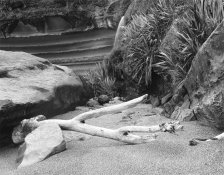Care to clarify with a numerical example?
Sure - just to clarify and give proper credit, these figures were taken from the chart in the book Way Beyond Monochrome, co-authored by our very own Ralph Lambrecht...
Let's assume a base exposure time of 12s. If you have an area of the image which needs -2/3 of a stop, you will subtract 4.4s, so that area will receive 7.6s total. Another area needs +2/3 of a stop...but you will add 7s, giving that area a total of 19s. Notice the difference in the times in burning vs dodging - minus and plus 2/3 aren't the same number.
But here's the thing...I used a nice round number for the base time, but that might not always be the case. If you're making your test strips in f stop increments (which are easier to interpret), the base time could be 14.3, 22.6, 10.7...whatever. And then your dodging and burning times are all over the place.
Now...I'm not saying your method of rounding the numbers up or down is wrong or bad, but if you're doing it the "proper" way (if there is such a thing), then the tenths are important.





